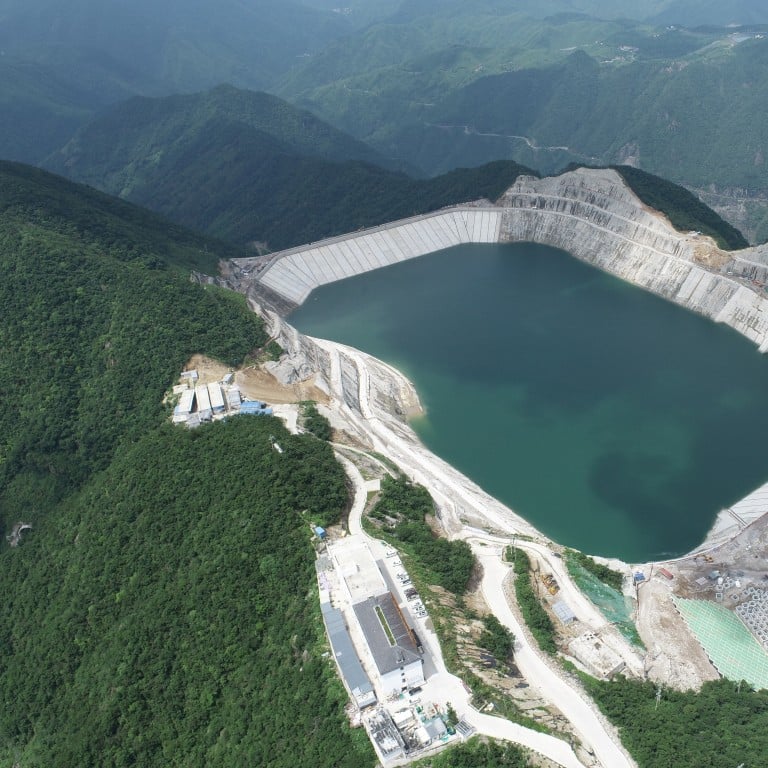
China pumps up hydropower storage plans to meet climate commitments
- After failing to meet 2020 target for pumped storage, Beijing aims to double capacity in the next five years
- Energy storage will be essential if the country is to meet its pledge to more than double renewable sources over the next decade
Pumped storage hydropower is the most common type of energy storage in use today, accounting for more than 94 per cent of installed capacity worldwide. It saves excess power by using it to pump water from a lower to an upper reservoir at night, when electricity demand is low, and releasing it to generate power during the day when demand is high.
But, due to a lack of power tariff incentives and geological constraints, China’s installed pumped storage stood at 31.5 gigawatts by the end of last year, 20 per cent lower than the 40GW target set out in the 13th five-year plan.

03:05
China vows carbon neutrality by 2060 during one-day UN biodiversity summit
China aims to reach peak carbon dioxide emissions by 2030 and carbon neutrality by 2060 and President Xi Jinping pledged in December to more than double the country’s wind and solar capacity – from 535GW to 1,200GW – over the next decade. But the intermittency of renewable sources makes the development of energy storage essential.
China’s National Energy Administration said last week it aimed to double pumped storage capacity within five years, to more than 62GW by 2025. It wants to further expand capacity to 120GW in the following five years and achieve an internationally competitive industry by 2035.
NEA official Ren Yuzhi said China led the world in terms of installed capacity of pumped storage and capacity under construction but it accounted for 1.4 per cent of the country’s national grid, a relatively low percentage compared with developed countries, according to Communist Party mouthpiece People’s Daily.
A 2009 plan by the administration picked sites for pumped storage projects with the aim of achieving 110GW capacity by 2020, but so far China has only about 90GW capacity either installed or under construction – “insufficient to meet the demand of building a new type of power system with renewable energy playing a dominant role”, Ren said.
The People’s Daily report called on provinces and cities to plan and speed up pumped storage projects based on their demand and the development of renewables.
China’s goal to be carbon neutral by 2060 to cost US$15 trillion, report says
Experts said that while the central authorities understood the importance of pumped storage hydropower in the grid system, provinces had been slow to act because of their dependence on coal and the absence of peak power tariffs.
“We had a lot of coal-fired power plants during the 13th five-year plan period. When there was an electricity demand, we would turn to coal,” said Yang Fuqiang, a research fellow with Peking University’s Institute of Energy.
Lin Boqiang, dean of Xiamen University’s China Institute for Studies in Energy Policy, said China needed to set a price differential between peak and off-peak hours for power consumers. “The peak tariff should be as least three times higher compared with the off-peak tariff so that pumped storage projects can be profitable.”
With the advent of the 14th five-year plan period, Chinese provinces are now ramping up pumped storage capacity. According to research by Everbright Securities, 16 out of 31 provinces have made plans for pumped storage.
The eastern province of Zhejiang aims to build 3.4GW of pumped hydro capacity from 2021 to 2025, bringing its total capacity to 15GW. Guangdong in southern China has plans for five new pumped storage projects by 2025 and its neighbouring province Hunan has confirmed one project, with five more on the drawing board.
“Pumped storage is commonly used and economically feasible, but it’s a scarce resource,” said Yang of Peking University. “[Pumped storage] mainly supports local grids, so it needs to be built in mountainous areas where there is power demand.”
While pumped storage is efficient and low cost, it is constrained by its geographical requirements, according to David Fishman, manager at energy consultancy The Lantau Group. “The cost per megawatt-hour of pumped storage should be among the lowest of different types of storage technologies and the efficiency is pretty good,” he said.
“It’s limited in its application because it has geological constraints.”


